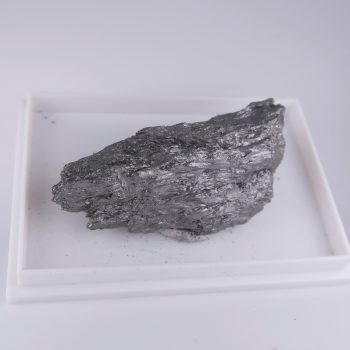Graphite
Graphite is a mineral that is composed of carbon atoms arranged in a layered structure. It is a soft and slippery material that is often used as a lubricant, as well as in the production of pencils, batteries, and other industrial products.
Graphite is also a good conductor of electricity, and is used in electronic devices such as touch screens and solar panels.
Showing all 2 results
Information about Graphite
Appearance
Graphite is a dark coloured carbon mineral, which is very soft due to layers which part easily.
Uses and History
Graphite is used for a range of industrial purposes, but by far its most well known usage is as pencil ‘lead’ – no lead is used in modern pencils, just graphite.
It is used as battery anodes, and as a dry lubricant. It is lightweight and has extremely high heat resistance. It is inert with almost any other material.
Graphite was originally named ‘plumbago’ in 1739, and named ‘molybdaena’ in 1781; it was eventually named ‘graphite’ in 1789 by Abraham Gottlob Werner from the Greek ‘graphein’, ‘to write’. It was probably confused with black lead and plumbago due to a passing resemblance to the lead ore galena.
It has been used since antiquity for various reasons – during the Neolithic it was used to decorative pottery. It was used to improve the quality of cannonball molds, and has also been used for polishes, lubricants, paints, crucibles, pencils.
Graphite was originally named ‘plumbago’ in 1739, and named ‘molybdaena’ in 1781; it was eventually named ‘graphite’ in 1789 by Abraham Gottlob Werner from the Greek ‘graphein’, ‘to write’.
It was probably confused with black lead and plumbago due to a passing resemblance to the lead ore galena. It has been used since antiquity for various reasons – during the Neolithic it was used to decorative pottery. It was used to improve the quality of cannonball molds, and has also been used for polishes, lubricants, paints, crucibles, pencils.
Nowadays, it is used in refractory materials and batteries – even modern batteries use a considerable amount of graphite. There are some more complex uses for graphite, including radar absorbent materials and other futuristic materials.
Mineralogy
Hazards and Warnings
Dust can be extremely bad for electronics – it was a major reason for astronauts switching away from pencils to the ‘Fisher space pen’.
Mineral collectors should wash their hands after handling specimens, to avoid any exposure to potential toxins.
Almost all rocks, minerals (and, frankly, almost all other substances on earth) can produce toxic dust when cutting, which can cause serious respiratory conditions including silicosis.
When cutting or polishing rocks, minerals, shells, etc, all work should be done wet to minimise the dust, and a suitable respirator or extraction system should be used.
Translations
Arabic:
- الجرافيت
Hindi:
- ग्रेफाइट
Portuguese:
- grafite
Bengali:
- গ্রাফাইট
Indonesian:
Punjabi:
- گریفائٹ
English:
Italian:
- grafite
Russian:
- графит
French:
Japanese:
- 黒鉛
Spanish:
- grafito
German:
- Graphit
Korean:
- 석묵
Thai:
- กราไฟท์
Gujurati:
- ग्रेफाइट
Mandarin Chinese:
- 石墨
Urdu:
- گریفائٹ


